“If you want to know what color is fashionable this season, just look at this river.” A popular saying in the Zhejiang Qiantang river area of China.
Pollution is not a seasonal problem Each year that passes, the textile industry leaves a large footprint in the water in the production of about 80 billion garments. “ Mills can use up to 200 tons of water per ton of dyed fabric , which in turn only produces about 1400 pieces of clothing. Add everything together and roughly 17 to 20% of industrial water pollution is owed to fabric dyes and treatments. No one piece of fabric or clothing is to blame for dye pollution. Rather, it’s the estimated 8,000 synthetic chemicals used to bleach, treat, and brighten our clothes that pose the problem.”
A blatant example of this world-wide problem was shown vividly in the documentary “RiverBlu .” Roger Williams, the executive producer exposed the fashion industry’s effect on freshwater, and the pollution witnessed during production. "We came across a satellite photo from China, and it was just this big stain of blue coming down into the ocean,” he said. "They're just letting the dyes run right into the rivers.” RIVERBLUE demands for significant change in the textile industry.
According to Greenpeace , the most frequently used additives in the dyeing and finishing process are toxic to aquatic life, remains in the environment and can continuously accumulate.
We should use our imagination to address and solve these pressing problems.
Friends from AFFOA (Advanced Functional Fabrics of America) joined me at Change fashion.
Recent advances in color-change fiber technology will soon be available to enable color changes in fabrics, without the need for industrial water pollution created by the traditional fabric dyes process.
From my point of view, we can reduce the damage done to our environment and at the same time be part of the evolution of the future of fashion by methodically modifying the color dying process, to include color-change fiber technology. It can take some time for this to happen, like changing from combustion engine cars to electric vehicles. But it will happen.
Affoa’s color change technology differs from previously available color-changing fabrics, which contain light-emitting diodes (LEDs) that produces light of various colors. Instead, each thread is equipped with a micro-wire and a color-altering pigment. “When weaved into a garment, the aggregation of the fibers gives the illusion of a fabric that changes color.” (affoa.org)
Color-changing material can alter our lifestyle in very positive ways. With garments that change color, consumers can radically pare down the number of garments in their closets, as well as, reduce the dyes that are costly to our health and wellbeing. I am excited about the prospect of being able to change the color of our wardrobes without the dangers to human health, marine life, and our environment.
From my point of view, the use of advanced textiles will provide a radically new solution to a dangerous and recurring problems.
![]()
Veronica at Genspace Bio Lab NYC
THE FABIC REVOLUTION
As a fashion designer, my vision for the future of apparel is clothes that does more than just protect you from weather conditions or have you look fashionable. The use of advanced textiles provides new solutions to reoccurring problems.
The time has come for the indisputable connection between fabric and technology to change the way we dress and live.
“Our clothes help define us yet the fabrics we wear have remained functionally unchanged for thousands of years. Recent breakthroughs in fiber materials and manufacturing processes will soon allow us to design and wear fabrics that see, hear, sense, communicate, store and convert energy, regulate temperature, monitor health and change color — heralding the dawn of a fabric revolution.” (www.affoa.org)
Fashion designers, scientist and engineers are a unique combination of “Change Makers” with the inherent power to pave the way for the future of our fashion industry.
`











